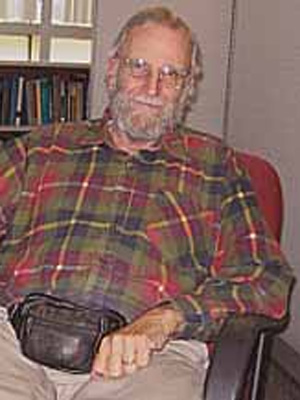EDUCATION
- Ph.D. (1964) Theoretical Physical Metallurgy, University of Pennsylvania
- S.M. (1962) Physical Metallurgy, Massachusetts Institute of Technology
- B.S. (1960) Metallurgical Engineering, University of Tennessee at Knoxville
PROFESSIONAL EXPERIENCE
- 2006 to Present: Senior Scientist (retired), now Guest Scientist, Department of Condensed Matter Physics and Materials Science, Brookhaven National Laboratory; Adjunct Professor, Physics and Astronomy Dept., Clemson University; Adjunct Professor, Department of Materials Science and Engineering, Stony Brook University
- 2002 - 2005: Deputy Chair, Materials Science Department, BNL
- 2001 - 2002: Interim Chair, Materials Science Department, BNL
- 2000 - 2001: Associate Chair, Energy Sciences and Technology Department (ES&T), BNL
- 1990 - 1992, 1996 - 2001: Division Head, Materials and Chemical Sciences Division, ES&T, BNL
- 1990 - 2006: Senior Scientist with Tenure, BNL
- 1981 - Present: Adjunct Professor, Materials Science and Engineering Dept., Stony Brook University
- 1979 - 1990: Physicist, with Tenure, BNL
- 1976 - 1978: Physicist, BNL
- 1972 - 1975: Associate Physicist, BNL
- 1966 - 1971: Assistant Professor of Solid State Sciences, Princeton University
- 1965: NATO Postdoctoral Fellow, United Kingdom Atomic Energy Research Establishment, Harwell, England
RESEARCH AREAS
- Materials Systems: Metals, in the most general sense, especially metallic oxides, intermetallic compounds, and degenerate semiconductors
- Structures: Cuprates, cobaltates, manganites, Half-Heusler and LAST-M compounds, metallic tellurides and selenides
- Current Research (Brief Description) "Continuum physics of phonons and electrons in imperfect metals and semiconductors."
TOPICS OF INTEREST
Internal and external fields (e.g. mechanical, electric, magnetic) and nanoscale structure play vital roles in the physical and chemical properties of functional materials such as complex oxides and intermetallic compounds. Such compounds are of interest because of their manifestations of correlated-electron phenomena such as superconductivity and magnetic order, as well as other useful behavior such as thermoelectricity. The effects and origins of fields in imperfect, i.e. �real�, solids are intimately intertwined with defects and other inhomogeneities in the crystal structure. It is the goal of this work to develop theoretical models of the continuum physics and thermodynamics of fields, especially stress fields, and structures in functional materials with microstructures or with sizes having length scales between a few nanometers and several micrometers, i.e., the mesoscale. These models are then used to investigate the effect of fields and defects on physical properties controlled by phonons and mobile electrons.
Such continuum models are often quite useful for their phenomenological, descriptive, and heuristic values, and they can aid in the understanding of physical and chemical properties and processes in advanced functional materials. At present my particular interest and emphasis is on �complex metals� such as transition metal oxides that can exhibit electronic conductivity, as well as intermetallic compounds and degenerate semiconductors, i.e., topics in 21st century theoretical physical metallurgy. At present I am particularly interested in phonons and their interaction with defects and nanoscale structure and in the development and use of continuum physics descriptions of electron-phonon interactions.
TOPICS OF INTEREST
- Haibin Su and D.O. Welch, "Effects of space charge, dopants, and strain fields on surfaces and grain boundaries in YBCO compounds," Supercond. Sci. Technol. 18, 24-34 (2005).
- Vyacheslov F. Solovyov, Harold J. Wiesmann, David O. Welch, and Masaki Suenaga. "Three and four micrometer thick YBa2Cu3O7 layers with high critical-current densities on flexible metallic substrates," J. Appl. Phys. 99, 013902 (2006); Virtual Journal of Applications of Superconductivity, January 15, 2006.
- W. Wong-Ng, L.P. Cook, Haibin Su, M. Vaudin, C.K. Chiang, D. Welch, E.R. Fuller, Jr, Z. Yang and L.H. Bennett, Phase Transformations in the High Tc Superconducting Compounds Ba2RCu3O6+d(R=Nd, Sm, Gd, Y,Ho, and Er)", J. Res. of the Nat. Inst. Stds. Technol. 111 [1], 41-55, 2006).
- Yoo Seung Lee, Djordje Djukic, Ryan M. Roth, Robert Laibowitz, Tomoyuki Izuhara, Richard M. Osgood, Jr., Sasha Bakhru, Hassaram Bakhru, Weidong Si, and David Welch. Fabrication of patterned single-crystal SrTiO3 thin films by ion slicing and anodic bonding. Applied Physics Letters 89 [12] 122902-122904, (2006).
- D.A. Fischer, A.R. Moodenbaugh Qiang Li, G.D. Gu, Yimei Zhu, J.D. Davenport, D.O. Welch, and Haibin Su; MgB2 surface monitored by the boron K x-ray near-edge spectrum. Modern Physics Letters B 20 [19] 1207-1216 (2006).
- Djordje Djukic, Kenneth Evans-Lutterodt, Ryan M. Roth, R. M. Osgood, Jr., Hassaram Bakhru, Sasha Bakhru, and David Welch. "X-Ray microbeam probing of stresses in patterned He+ implanted single-crystal LiNbO3." Applied Physics Letters 91, 11298 (2007).
- W. Zhang, G. Wei, H. Zhang, L. Zheng, D. O. Welch, S. Sampath."Toward the Achievement of Substrate Melting and Controlled Solidification in Thermal Spraying." Plasma Chemistry and Plasma Processing 27 [6], 717-736 (2007).
- H. B. Su, D. O. Welch, W. Wong-Ng, L.P. Cook and Z. Yang. "Manifestation of Anisotropy in Melting Systematics of RBa2Cu3O7-d (R= lanthanides)." Applied Physics Letters 91 [17] 172510 (2007).
|
